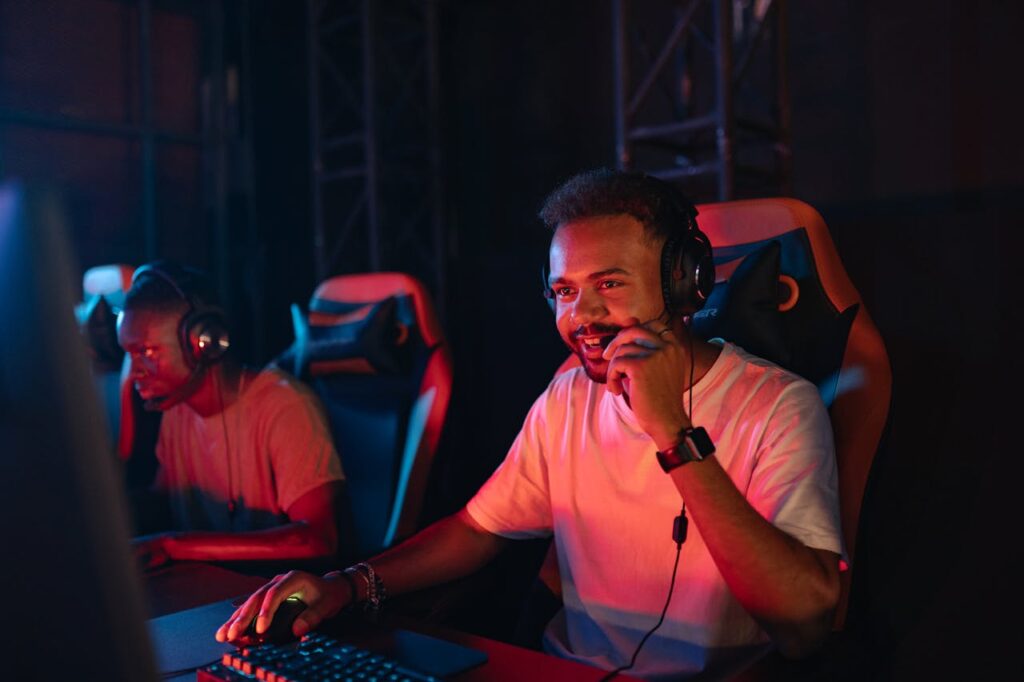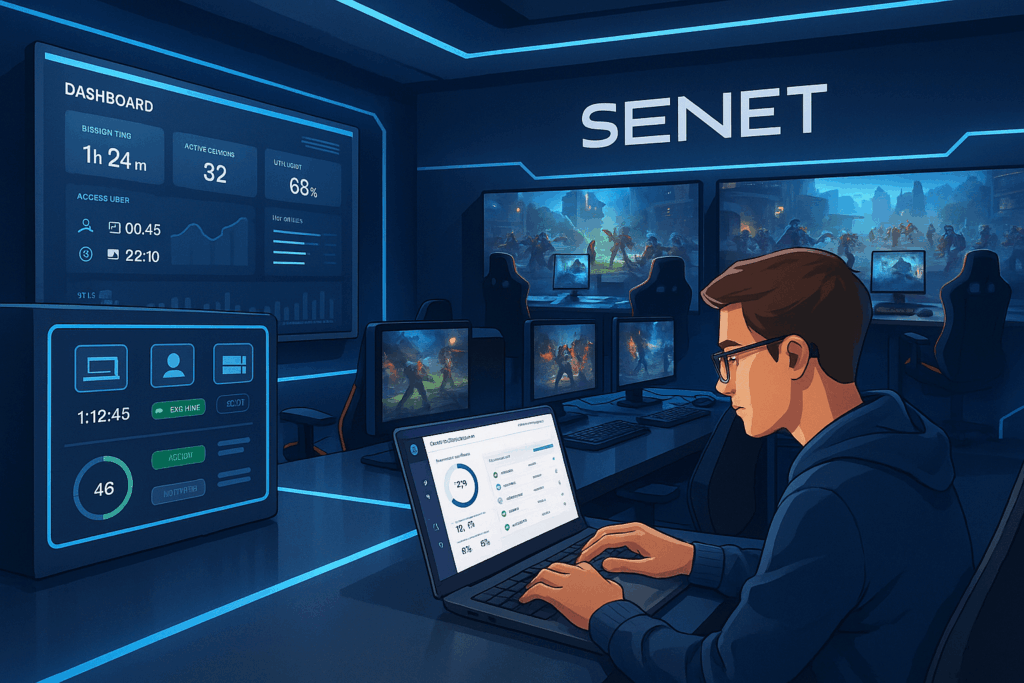Esports – organized competitive video gaming – has rapidly evolved from a niche hobby into a mainstream global industry. In Europe alone, the esports market generated over $600 million in revenue in 2024 and accounted for about 30% of the world’s esports audience. Major tournaments now draw viewership on par with traditional sports finals (from Wimbledon to the FIFA World Cup), and a generation of students (largely Gen Z) identify gaming as a primary form of entertainment. In response, universities across Europe are increasingly embracing esports as part of campus life and academia.
A growing number of institutions have established “smart” esports labs – state-of-the-art facilities for competitive gaming, training, broadcasting, and research – to harness this phenomenon. These labs are more than just computer rooms; they are high-tech hubs that support varsity esports teams, academic programs, and student communities.
This report examines how European universities in various countries (including the UK, Germany, France, the Nordics, Spain, and others) are building and utilizing esports labs. It explores the motivations behind these investments, the key infrastructure and technologies involved, ways esports is integrated into curricula and research, strategies for student engagement, and the partnerships with industry that help make these labs possible. Throughout, we highlight real-world case studies to illustrate best practices and trends across Europe.
The Growing Role of Esports in Higher Education
Once viewed as a fringe activity, esports has become a significant part of higher education culture. In North America and Asia, varsity esports teams and scholarships have existed for years, and Europe is now catching up rapidly. By the late 2010s, European universities began recognizing esports much like traditional sports – as an avenue for student talent development, institutional prestige, and community building. Key esports events attract millions of viewers globally, comparable to Tier-1 sports championships, which has underscored esports’ legitimacy to educators and administrators.
Multiple indicators show esports’ surging presence on European campuses. As of 2019, experts observed that universities were “building out esports labs where their local teams can practice, equipped with high-end gaming PCs and broadcasting equipment,” and some even established full esports arenas for live spectators. In the past few years, this trend has only accelerated.
Many higher-ed institutions in Europe (and EMEA broadly) have created dedicated esports studios with professional gaming and streaming setups, and some have gone even further – constructing on-campus esports “stadiums” with giant screens to host live tournaments for hundreds of fans. This movement reflects the reality that esports is “now one of the biggest entertainment markets on the planet”, as University of Salford’s program director Iain Earle remarked. Universities are not only acknowledging the popularity of esports but actively bringing it into their strategic plans.
Why Universities Are Investing in Esports Labs
What motivations drive European universities to build esports labs? Several strategic goals are commonly cited by institutional leaders:
- Attracting and Recruiting Students: Offering esports facilities and programs is a way to appeal to the new generation of tech-savvy students. Many youths who grew up with gaming might choose a university that supports their passion. In fact, colleges see esports as a tool to draw in students who might not otherwise have engaged with traditional campus activities. A recent analysis noted that esports appeals strongly to those interested in technology and digital media, helping institutions “attract talented students” in those domains. This competitive advantage in recruitment is a major driver, especially as universities compete for enrollment.
- Student Engagement and Retention: Beyond recruitment, esports labs enhance the campus experience. They provide a new avenue for student involvement, leadership, and social connection. Esports programs contribute to a vibrant campus culture, offering a shared interest that brings together students from diverse backgrounds. Not everyone plays varsity football or joins the orchestra, but many can connect through gaming.
- University administrators observe that esports clubs and events can foster inclusivity – for example, gaming communities often involve a mix of genders, nationalities, and academic disciplines cooperating as teams online. By improving student life and creating a sense of belonging, esports labs may also support retention (students who are deeply engaged in campus activities are more likely to stay and succeed).
- Academic Innovation and Career Preparation: Universities also recognize that esports is big business – an emerging ecosystem of professional teams, broadcasters, event organizers, game developers, and more. Forward-looking institutions want to prepare students for careers in this growth industry. Integrating esports into academic offerings (discussed in the next section) and providing hands-on labs helps develop skills in event production, digital content creation, marketing, game design, and data analytics.
- New courses and even degrees in esports management, game development, and media production are opening pathways into a multi-billion-euro sector. As one industry report noted, some European colleges have started to offer esports in the curriculum and even specialized degrees, ensuring graduates are ready for roles in the esports and gaming industry. In short, esports labs support experiential learning in a field that didn’t exist a decade ago – giving universities a cutting-edge academic appeal.
- Institutional Reputation and Modernization: Embracing esports aligns with universities’ goals of staying relevant and innovative. It signals to prospective students, faculty, and partners that the institution is plugged into contemporary cultural and technological trends. In countries like the UK and Germany, early adopters of esports in academia garnered significant media attention and reputational boosts.
- For example, when Staffordshire University launched one of the first esports degrees in Europe, it reinforced the university’s pedigree as a pioneer in digital media education. Universities see these labs as flagship projects showcasing modern facilities and pedagogies, which can improve their standing in certain student markets and even attract funding. Supporting esports can also strengthen ties with local communities and industries (e.g. tech companies, regional development initiatives), positioning the university as a hub of digital innovation.
- New Revenue and Partnerships: Although not the primary academic motive, some universities anticipate financial and networking benefits from esports. Successful esports programs can draw sponsorship deals (e.g. hardware suppliers sponsoring a lab), media rights for collegiate tournaments, or event revenue from hosting competitions. For instance, collegiate esports leagues often involve corporate sponsors (technology brands, gaming companies, even consumer brands) who provide funds or equipment in exchange for access to the student demographic.
- Universities with prominent esports teams might host large events that sell tickets or attract streaming audiences, generating income and publicity. Additionally, an esports lab can be a platform for partnerships – for example, a tech company might choose a university lab as a testbed for new products or as a talent pipeline. We will explore specific partnerships in a later section, but it suffices to say that the prospect of sponsorship and industry collaboration is an added incentive for universities to invest in esports infrastructure.

In summary, European universities build esports labs to recruit students, enrich campus life, pioneer new academic programs, enhance their reputation, and connect with a booming industry. As a Lenovo education report succinctly put it: universities are making these investments because they see esports as “key to attracting and motivating students” in the modern era. The next sections delve into what these labs consist of and how they integrate into the academic mission.
Key Infrastructure Components of a “Smart” Esports Lab
Building a competitive esports facility requires careful attention to technology and design. A “smart” esports lab typically combines top-tier gaming hardware, specialized software, and flexible space planning to meet both educational and competitive needs. Below are the key infrastructure components and best practices commonly seen across European university esports labs:
- High-Performance Gaming PCs and Consoles: At the heart of any esports lab are powerful gaming computers. Universities equip labs with high-end desktop PCs featuring the latest multi-core CPUs, ample RAM, and advanced GPUs capable of running esports titles at high frame rates (often 240+ FPS). For example, the University of Salford’s new esports suite includes 23 Yoyotech gaming PCs with Intel Core i9 processors and NVIDIA RTX 4080 graphics – machines on par with professional esports arenas. These PCs are typically paired with high-refresh (144 Hz or 240 Hz) monitors to ensure ultra-smooth visuals in fast-paced games. In addition, some labs incorporate gaming consoles (for titles played on Xbox/PlayStation or Switch) or VR setups if the curriculum involves them, though PC is the primary platform for most collegiate esports. All machines are networked on a low-latency local area network (LAN), often with gigabit switches and enterprise-grade routers to minimize lag. A reliable, high-bandwidth internet connection (sometimes with backup lines) is essential for online competition and streaming. Many labs even work with their campus IT to have a dedicated 10 Gbps fiber connection to ensure the lowest possible ping to game servers.
- . The environment is often enhanced with ambient LED lighting and team branding to create an immersive atmosphere. Climate control and ventilation are important too – a room full of gaming PCs and bodies can get warm, so robust air conditioning or cooling solutions are part of the build. These details in peripherals and setup ensure that students can practice and compete in conditions similar to professional esports athletes.
- Broadcasting and Streaming Equipment: A defining feature of smart esports labs is the integration of broadcast technology. Modern esports is as much about streaming and content creation as it is about playing, so universities are installing equipment to produce live broadcasts of matches and events. This typically includes multiple cameras (e.g. pan-tilt-zoom cameras and DSLRs or camcorders) to capture player reactions and in-room action, as well as video mixers (switchers) and production software to mix gameplay feeds, graphics, and camera feeds in real time. For example, Salford’s lab is fitted with Blackmagic 4K broadcast cameras and a television studio mixer to enable students to practice professional live production.
- Staffordshire University’s new esports hub likewise installed Panasonic 4K studio cameras and the Panasonic KAIROS live production platform – the same kind of system used in commercial sports broadcasts – to give students hands-on experience with industry-standard tools. In addition to cameras, labs have quality audio equipment: studio microphones for casters/commentators, headsets for players, mixing consoles for audio, and soundproofing in any casting booths or control rooms. Some labs include a dedicated broadcast control room or “gallery” adjacent to the gaming area, where student teams can manage the stream (switch camera angles, add overlays, etc.) just like a TV production. High-definition projectors or LED screens are often mounted in the lab or arena as well, so that spectators on-site can watch the live action and commentary. By building a mini-broadcast studio into the esports lab, universities ensure that students not only play games but also learn valuable media production and streaming skills – a key differentiator of a truly “smart” esports facility.
- Management Systems and Software: Managing an esports lab with dozens of high-end PCs requires sophisticated software support. Many European universities partner with platform providers (such as SENET, ggLeap, or similar esports center management software) to control and optimize their labs. These platforms allow lab administrators to centralize control over all machines – for example, they can deploy game updates or new software to every PC at once, monitor PC usage, and ensure security (locking down the systems from unauthorized installs). Administrators can schedule the use of the lab (for classes, team practices, or public hours) through a booking system, and even remotely manage the lab PCs without being physically present.
- On the user side, such platforms enhance the experience by letting students or players log into any machine with their account, access the library of games, and even make use of features like reserving PCs in advance or ordering food to the lab desk during a long practice. This kind of “smart lab” ecosystem streamlines operations and creates a seamless environment similar to a modern internet café or commercial esports arena. For example, SENET (developed by Enestech) provides an interface where club owners can control computers and update drivers on all PCs from one dashboard, while players can reserve a computer or console and even request services without leaving their seat. European university labs increasingly leverage these systems to reduce IT overhead and provide a polished, user-friendly gaming experience for students.
- Flexible Space Design (Furniture & Layout): A best practice in new esports labs is designing spaces that are multi-functional and modular. Unlike a static computer lab, an esports facility might need to host a class in the morning, a team practice in the afternoon, and a tournament with spectators in the evening. European universities have adopted clever design solutions: movable desks and gaming stations, retractable monitor setups, and seating that can reconfigure for different modes.

- The University of Warwick’s Esports Centre (UK) is one notable example – it’s a 24-seat high-tech gaming venue built with a £275,000 investment, and all of the equipment is on wheels or easily relocatable. This flexibility means the lab can function as a normal open gaming space day-to-day, but if a larger event is planned, the PCs and consoles can be rolled into a different arrangement or even moved to a bigger hall on campus to create a full-scale arena.
- Similarly, at Staffordshire University (UK), their new esports hub includes a 61-seat arena with two control galleries; the space is designed so that it can run two separate esports events or one integrated event, with control rooms able to operate independently or jointly for large productions. Having a built-in small arena (with tiered seating for an audience of around 60) on campus gives Staffordshire a venue to host inter-university matches or public showcases, while still doubling as a lab for student coursework.
- The lesson is that smart esports labs are designed not just for function, but also for adaptability. Features like modular furniture, spectator areas (even if modest in size), and proper lighting/acoustics transform a simple computer room into a true esports arena-lab hybrid. By doing so, universities maximize the usage of the space and ensure it can serve the broadest educational and community purposes.

